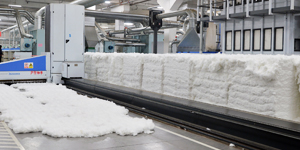
News
Basic knowledge of textiles
- Textile Common Sense
- Time of issue:2013-03-18 01:15
- Views:5
(Summary description)1. Cotton: Cotton fiber is the fiber covered by cotton seeds, referred to as cotton. The cotton fiber from which cottonseed is removed is called lint or raw cotton.
Basic knowledge of textiles
(Summary description)1. Cotton: Cotton fiber is the fiber covered by cotton seeds, referred to as cotton. The cotton fiber from which cottonseed is removed is called lint or raw cotton.
- Categories:Textile Common Sense
- Author:
- Origin:
- Time of issue:2013-03-18 01:15
- Views:5
1. Cotton: Cotton fiber is the fiber covered by cotton seeds, referred to as cotton. The cotton fiber from which cottonseed is removed is called lint or raw cotton.
Variety: According to the thickness, length and strength of the fiber, the raw cotton can be generally divided into three types: long-staple cotton, fine-staple cotton and coarse-staple cotton.
Structure: Cotton fiber is a tubular body with one end open, which is collapsed into a hollow band after ripening and drying. The main constituent material of cotton fiber wall is cellulose with high degree of polymerization. In dry mature cotton fiber, the content of cellulose is over 95%, which is a highly pure cellulose resource in nature.
Performance: Cotton fiber is generally thin and soft, and the skin feels more comfortable. It has a strong ability to absorb moisture. In general, the wetness of cotton fibers is stronger than dry. The elasticity is poor, and the cellulose can be creased and finished to have better shape retention. Cotton fiber has good warmth retention. At high temperatures, the plasticity is good. If the cotton fiber is in contact with sunlight for a long time, the strength will decrease, and the fiber will become hard and brittle: in the case of an oxidizing agent, bleaching powder or a dye having oxidizing properties, the fiber strength will also decrease and become brittle and hard.
2, hemp: hemp fiber is the earliest textile material for human beings.
Variety: ramie and linen
Structure: The chemical content of ramie fiber is generally 65% to 75%. The fibers after degumming are white and shiny, and the fibers are fine and dry. In Japan, ramie fabric is also known as ramie fabric. Flax cellulose accounts for 70% to 80%.
Performance: hemp fabric feels stiff, wrinkle recovery is poor, poor wear resistance; poor heat resistance, water wash resistance; good moisture absorption and desorption, good gas permeability and poor dyeability.
3, Mao
Variety: Cotton wool---In textiles, the narrow meaning of wool often refers to cotton wool. Cashmere---also known as cashmere, is a valuable textile material.
Structure: Wool fiber belongs to protein fiber, which mainly consists of scale layer, cortex layer and medulla layer.
Performance: The strength of wool fiber is poor, but the elasticity is good, the wool fabric is crisp, not wrinkle, and the plasticity is strong. Wool fiber is superior to other fibers in terms of warmth retention, and has good hygroscopicity and gas permeability. Good acid resistance, poor alkali resistance, and long-term sunshine hours. But it is easy to worm and mildew.
4. Silk: Silk fiber is the only long fiber in natural fiber.
Varieties: silkworm, tussah, ramie silkworm, cassava silkworm, etc., the best quality of silkworm.
Structure: The silk consists of silk fibroin and sericin.
Performance: mulberry silk --- hygroscopicity, good water resistance, poor water permeability, light resistance and heat resistance. Tussah silk --- poor dyeing, easy to produce water stains. Double palace silk --- poor gloss, thick fabric, unique style.绢丝---Processed from waste silk, waste sputum, sputum, etc., it has good gloss, strength, warmth and moisture absorption, but it is easy to fluff after washing.
5. Chemical fiber: Chemical fiber refers to a fiber made from natural or artificial polymer materials. It can be divided into recycled fiber and synthetic fiber depending on the source of the raw material.
Variety: Recycled fiber (recycled cellulose fiber, rich and strong fiber) synthetic fiber (polyester, nylon, acrylic, vinylon, chlorin, spandex)
Performance: Regenerated cellulose fiber---feel weak soft gloss, good moisture absorption, good air permeability, good dyeability; but wet fastness and poor elasticity.
Rich and strong fiber---high strength, durable, low shrinkage, good elasticity and alkali resistance.
Polyester---good elasticity, good strength and wear resistance, not easy to deform; but poor hygroscopicity, non-breathable, easy to fluff and ball.
Nylon---high strength, good wear resistance; poor hygroscopicity, poor permeability, easy to fluff and ball.
Acrylic fiber---also known as synthetic wool, has poor hygroscopicity and poor wear resistance.
Weilun---also known as synthetic cotton, has good hygroscopicity and good wear resistance, light resistance and corrosion resistance.
Chlorinated fiber --- strong chemical resistance, good thermal insulation properties; but poor heat resistance.
Spandex---also known as Lycra, excellent elasticity. It is generally plied with other fibers or made into a core yarn.
Spinning
1. Yarn: Yarn is a continuous fiber bundle made by a method in which short fibers are gathered together by twisting.
Variety:
1. According to the thickness of the yarn: coarse yarn, medium yarn, fine yarn
2. According to the textile process: combed yarn, carded yarn
3. According to the dyeing processing points: primary yarn, dyed yarn, color spinning, bleached yarn, mercerized yarn
4. According to the spinning method: ring spinning, air spinning, electrospinning, vortex spinning
5. According to the length of the fiber: cotton yarn, medium long yarn, wool yarn, filament yarn
2. Line: The line is made up of two or more single yarns combined and twisted, or called strands.
Variety:
1. According to the shape structure of the yarn: single yarn, strand, multi-strand, fancy, textured yarn
2. According to the type of fiber constituting the yarn: purely spun yarn and blended yarn
3, according to the use: woven yarn, knitting yarn, yarn for raising, sewing yarn, special industrial yarn
Performance:
Line density--- refers to the thickness of the yarn, according to national standards, called Tex, referred to as tex, 1tex = 1g / km.
Line twist - the number of turns in the unit length of the yarn. The twisting of the yarn is directional, with Z捻 and S捻. Generally, the single yarn is Z捻, the combined yarn is S捻, and the twisted yarn is generally represented by Z/S.
Moisture regain rate---Because the hygroscopicity of fibers and yarns varies with the surrounding environment, the regain rate of various textile materials is uniformly regulated in commercial trade for the convenience of pricing.
Moisture regain (%) = 100 × (wet weight - dry weight) / dry weight
The nominal moisture regain of the yarn
Type of yarn, regular moisture regain
Cotton yarn 8.5 (Inch system 9.89)
Linen yarn 12.0
Ramie yarn 10.0
Combed wool yarn 16.0
Carded wool 15.0
绢woven silk 11.0
Viscose yarn and filament 13.0
Nylon yarn and filament 4.5
Polyester yarn and filament 0.4
Acrylic yarn 2.0
Velon yarn 5.0
Polyester/cotton yarn (65/35) 3.2 (Inch 3.7)
Third, weaving
1. White blank: A cloth woven from primary color cotton yarn without being dyed or printed, collectively referred to as a primary color cloth. It is generally called a grey cloth.
Variety: The grey cloth is divided into city cloth, ordinary city cloth, fine cloth, coarse cloth, twill cloth, and wrapping cloth.
2, yarn-dyed: yarn-dyed fabric is bleached or multi-colored cotton, wool, silk, hemp and chemical fiber yarn, woven by the change of fabric structure.
Variety: The color and variety of yarn-dyed fabrics and various specifications are widely used.
Performance:
1. Use different colors of yarn to match the fabric to form a variety of beautiful flower patterns, which have a three-dimensional effect than the general printed cloth.
2. Due to the dyeing of the original yarn, the dye has strong penetrability, so the dyeing fastness is good.
3. Weaving uses multi-shuttle, multi-arm weaving, which can interweave different fibers or different yarns into a variety of colorful and sleek varieties.
4. Due to the use of color yarns or color yarns and various tissue changes, the quality of the cotton yarn can still be woven into a beautiful variety.
3, jacquard
Jacquard is divided into color jacquard and structural jacquard. Color jacquard refers to a fabric that is interwoven with yarns of different colors, that is, a yarn-dyed fabric. Structure Jacquard is a fabric that is woven by different interlacing methods of the same color yarn. It has a three-dimensional structure and has a concave and convex feeling.
Fourth, dyeing and finishing
1. Dyeing: Dyeing is the process in which a dye or fiber is physically or chemically combined to cause the textile material to be colored.
Variety:
1) Direct dyes, reactive dyes, sulphur dyes, vat dyes and insoluble azo dyes, mainly used for dyeing cotton fibers.
2) Acid dyes and acid mord dyes are used for dyeing protein fibers such as wool and silk.
3) Disperse dyes are mainly used for dyeing polyester and nylon.
4) Cationic dyes are mainly used for acrylic dyeing.
Performance: Dyeing requires uniform color and good dyeing fastness, including sun exposure, climate, soaping and other fastness.
2, printing: printing is the process of printing patterns on textiles with dyes or pigments.
Variety:
Direct printing---Print the printing paste on white or light-colored fabric, and then obtain it by steaming and so on.
Discharge printing - the fabric is first dyed on the ground color, and then printed with a dye.
Anti-dye printing---Adding anti-staining agent to the printing paste to make the dyeing irregular.
Transfer printing - dyeing with the performance of disperse dyes in response to heat sublimation.
3. Finishing: After the fabric has been bleached, dyed and printed, the process of further improving the quality of the fabric through physical or chemical methods is called finishing.
Variety: cotton, linen material finishing, silk clothing finishing, wool finishing, chemical fiber and its blending, interwoven fabric finishing
Performance: Through finishing, the fabric door width is uniform or uniform, and the shape and shape are stable; the fabric feel is improved; the appearance of the fabric is improved; the other taking functions are improved (waterproof, oil-proof, anti-microbial, etc.); the functionality of the fabric is increased, and the fabric is improved. Added value (UV, mildew, anti-mite)
Fifth, clothing manufacturing
1, cutting terms
1) 劈 potential: the deviation of the line, such as the amount of bias at the upper end of the door
2) Lifting: The improvement of the horizontal line, such as the bottom edge lifting, refers to the distance between the bottom line of the top and the long line of the garment.
3) Difficulties: The deviation of the straight line, such as the side trousers of the trousers, refers to the amount of deviation at the upper end of the back hem.
4) Concave: The degree to which the sleeves and the trousers are recessed before and after the shackles.
5) Drawing: Single-piece drawing refers to drawing the cutting lines according to the specifications according to the specifications.
6) Open the cut: Cut the cut into pieces according to the line of the drawing.
7) Eye knife: Cut a small gap in a part of the piece to make a positioning mark.
8) Drilling holes: Holes that are used as positioning marks on the pieces.
9) Change the film: Replace the piece that does not meet the quality requirements.
10) Matching materials: sporadic accessories other than the main pieces such as dress skirts.
11) Silk crepe: the warp, weft, and diagonal directions of the fabric, also known as straight silk crepe, horizontal silk crepe, and oblique silk enamel.
12) Arc: A curved line, such as a sleeve arch.
13) Tool setting: The eye knife is opposite to the eye knife or the eye knife is opposite to the seam.
14) Noodle: The crease of the door.
15) Lost: refers to some loose raw materials, which are lost after being cut and cut by warp and weft yarns.
2, fabric front and back identification
1) According to the texture of the fabric: common weaves are plain, twill and satin. The front and back sides of plain weave fabrics are not much different in appearance, so there is often no difference between them; twill fabrics can be divided into yarn fabrics and thread fabrics. The positive aspect of the woven fabric twill is clear, and the surface of the fabric is sturdy. The front and back lines of the fabric are more pronounced, with a frontal grain orientation; satin fabrics are divided into warp satin and weft satin. The warp yarn on the front surface of the satin has more floats, and the front weft yarn of the weft surface floats more. The front surface of the satin fabric is relatively flat and shiny, and the reverse weave is not obvious, and the gloss is dull.
2) According to the pattern and color of the fabric: the patterns and patterns of various fabrics are clear and clean, the lines are obvious, the layers are distinct, and the color is bright; the reverse is relatively light and fuzzy.
3) According to the fabric jacquard and jacquard stripe recognition: the front stripe or pattern of the jacquard fabric is obvious, the line outline is clear, and the gloss is pure and beautiful.
4) According to the edge recognition of the fabric: the front side of the fabric is flatter than the back side; the edge of the back side is curled inward. Some fabrics have text on the edges of the fabric, the front text is written and clear, and the reverse text is blurred.
5) According to the factory seal identification: some fabrics are covered with a round factory seal within 5cm, and the general seal is on the front.
3, shrinkage rate test
The reason why the fabric shrinks is because the fabric itself has hygroscopicity and is stretched and bent during the weaving process, and is stretched and stretched by printing, so that the fiber or the yarn is continuously deformed by the external force and temporarily stabilized during drying. However, when the moisture is encountered and the deformed portion is quickly restored after being heated and ironed, the violent contraction is caused. The shrinkage rate depends mainly on the mechanical strength during the textile production process and is related to the density of the fabric. There are four commonly used methods for fabric shrinkage test:
1. Natural shrinkage test
By the method of ventilating, the fabric is naturally retracted by the influence of outside air, wind, light, heat and water vapor. The test method is to disassemble, relax, and let go of the entire folded material for 24 hours and then calculate the shrinkage rate.
2, dry scaling test
The dry scalding rate refers to the degree of shrinkage of the raw material after being heated by ironing, by ironing the raw material back and forth according to the highest temperature that the raw material can withstand, measuring its length and width after cooling, and then ironing The shrinkage rate was calculated by comparing the length and width of the raw materials before ironing.
3, water spray shrinkage test
Water spray shrinkage refers to the re-shrinkage of water by spraying the raw material to moisture. Spray the raw material of the sample with clean water, and the water should be even. Then, the original material of the sample is kneaded by hand, then flattened, dried naturally in the room, dried, and then flattened, and then the shrinkage rate is calculated.
4, water immersion rate test
The water immersion test refers to immersing the sample material in water to cause retraction. The sample material is immersed in clean warm water at 60 ° C, rubbed by hand, and immersed in water for 15 minutes, then taken out. The raw material of the sample is folded in half, and then folded into a square shape, and the water is pressed out by hand, and then the flattening and drying are performed to calculate the shrinkage rate.
4, marker
Drawage requires reasonable nesting and reasonable splicing. Reasonable arranging refers to the pattern of saving materials in the premise of ensuring the quality of the piece. The arranging is a reasonable arrangement of the different shapes of the parts and components. The parts and components of the garment vary. In the drawing, you should make full use of the different angles of the pieces, the shape of the bend and other shapes.
Reasonable discharge should be arranged in a compact manner to reduce the gap. Reasonable splicing. In order to improve the utilization of raw materials, proper splicing is allowed in the secondary parts of some parts. When splicing, the number of splicing parts, the number of spliced pieces and the spliced wire splicing should be carried out in accordance with the relevant technical regulations and the requirements of the wearer. It is not possible to increase the splicing seam and change the splicing thread. Splicing must do the following:
1. Minimize sewing troubles
2. To meet the splicing range and silk thread requirements allowed by the product model
3. To obtain permission from the wearer
4. Indicate the matching mark on the joint
Single-piece discharge refers to single-piece cutting and discharge, and industrial cutting generally refers to multiple-piece discharge. There is a certain gap between the requirements for single-piece discharge and precision discharge, and the savings are limited by the materials, so the consumption is more than the general work.
Scan the QR code to read on your phone

Official Account Platform
Copyright © 2019 Fujian Changyuan Textile Co.,Ltd., All Rights Reserved. 闽ICP备08000598号-1
Powered by www.300.cn


 EN
EN 中文
中文




